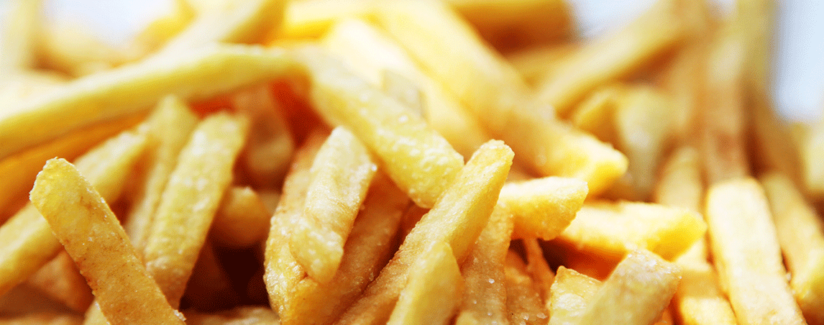
The French Fry: How Innovation Has Made It Even Better
French fries are one of our favorite indulgences, so we set out to learn what makes them so delectable. The discovery started by digging up the dirt on potatoes with Dr. David Douches, director of the Potato Breeding and Genetic Program at Michigan State University.
All fries begin life as a potato, so how do they grow?
Dr. Douches: “The potato from a crop perspective is unusual in that it is vegetatively propagated (the new plant is grown from the original plant) rather than through a seed. However, over time the potatoes accumulate viruses from growing in the field and they start to degenerate. If you save an actual seed from this starchy vegetable, you don’t maintain the variety. The unique genetic combination you have is lost.
“Potato breeding remained largely unchanged for 50 years until recently. When USDA and universities invested in public potato breeding efforts, they started making crosses and taking those families to the field and making selections, going through cycles of evaluation selection to sort through and find the best potatoes.”
How have potatoes developed over time?
Dr. Douches: “It was a Rev. Goodrich in upstate New York who got some potatoes and started making crosses. Our Russet Burbank potato, which is used for making french fries, comes from that lineage. Russet Burbank actually came from a chance seedling that was selected by Luther Burbank in the 1860s. That potato hung around for a while and a Russet mutation was found in it in the late 1800s and early 1900s. The Russet Burbank potato was well adapted to growing in the Pacific Northwest and so during World War II, they were using that to make potato flakes for the war effort. It was after World War II that the frozen fry industry started up as an innovative idea.”
How does genetic engineering play a role in making better potatoes?
Dr. Douches: “Having the ability to insert genes allows us to improve the traditional breeding practice because we can make a selection and have the potential to improve it further for certain key traits, like what has been done with the Innate potato. Some of those things are difficult, if not impossible, to do conventionally, as is the case with the insect resistance trait. Genetic engineering gives a tool to correct varieties that have some deficiencies and make them better for consumers, farmers and even processors, depending on the trait. Plus, we now have DNA sequence on the potato, which has allowed us to develop more analytical breeding schemes to follow certain genes in the potato. That’s really changing the landscape for the breeding.”
How can we know these GM (genetically modified) potatoes are safe to eat?
Dr. Douches: “They have to go through the federal regulatory agencies to get approval, which is a very extensive examination to determine whether the potatoes are safe to eat or safe to grow in the environment and whether they have any genes that may have an effect on the organisms in the environment. They look at insect-resistant genes, virus-resistant genes, and disease-resistant genes and whether they’re going to have any negative effects on the environment. Our non-GM food crops are not put through that gauntlet of analysis, so the most tested food we have out there is our GM-developed crops.”
What can we expect from potatoes in the future?
Dr. Douches: “They’re going to be self-driving and they’re going to fly like drones! No, what’s happening is the consumer is going to continue to get potatoes that are more healthful and are packed with more nutrition. But what they won’t see is that these potatoes are also performing on the farmers’ fields, giving them more resistance to the biotics problems like diseases and insects and also to problems like water needs or climate stresses.”
Potatoes are part of the equation; it also takes oil to give a french fry its flavor and texture. To learn more about innovation in oil, we went to Best Food Facts dietitian Sarah Downs.
What is new in frying oils?
Downs: “High-oleic soybeans are varieties developed with farmers and end-use consumers in mind. They have the same yields as other soybeans but offer higher-functioning soybean oil that remains stable in high-heat conditions, can add shelf life to products and, most importantly, contains less saturated fat, no trans-fat and has the highest amount of heart-healthy monounsaturated fat available in soy. Ultimately, high-oleic soybeans have a healthier oil profile and increased oil stability.”
What sets it apart from other oils?
Downs: “It has oil stability and contains monounsaturated fats. Many oils naturally are high in monounsaturated fats but are not very shelf stable.”
Does that mean it is healthier than other oils?
Downs: “There are many types of oils that can provide health benefits in moderation (canola and olive oil are two), and ultimately it depends on how you are using them because different oils are best for different types of cooking. High-oleic oil is a good choice because it is high in unsaturated fats, low in saturated fat and has no trans fat. Monounsaturated fats have been shown to lower LDL cholesterol (the bad kind) without lowering HDL cholesterol (the good kind), which may help reduce the risk of heart disease and stroke.”
French fries and frying oils are truly a story of food innovation. Check out the infographic below to learn more about the evolution of the french fry.



























